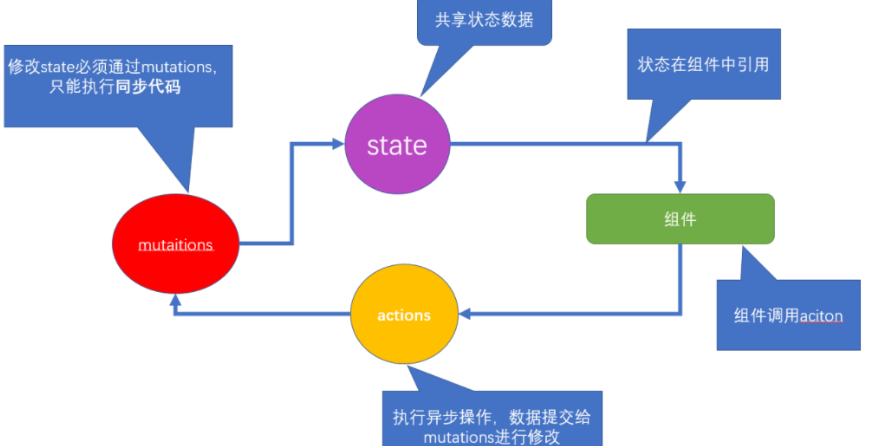vuex基础知识
什么是vuex
官方介绍:Vuex 是一个专为 Vue.js 应用程序开发的状态管理模式。它采用集中式存储管理应用的所有组件的状态,并以相应的规则保证状态以一种可预测的方式发生变化。
总结:vuex是一个集中式管理组件依赖的共享数据的工具,可以解决不同组件数据共享问题。
vue的引入
可以在使用脚手架手动创建项目的时候就选中vuex,会自动引入。或者:
1 | npm install vuex --save //安装 |
1 | import Vue from 'vue' |
vuex核心模块
vuex核心: state,mutations,actions,getters,modules

state
state是放置所有公共状态的属性,如果你有一个公共状态数据,你只需要定义在 state对象中。下面就是定义了一个存储数字的count。
1 | const store = new Vuex.Store({ |
我们怎样在其他组件使用state里面的值呢?
主要是两种方式:
1.原始形式
组件中可以使用 this.$store 获取到vuex中的store对象实例,可通过state属性属性获取count, 如下:
1 | <!-- 通过this.$store.state.count使用 --> |
2.辅助函数 mapState
mapState是辅助函数,帮助我们把store中的数据映射到 组件的计算属性中, 它属于一种方便用法
1 | import {mapState} from 'vuex' |
然后直接当作计算属性使用:
1 | <!-- 使用插值表达式获取 --> |
我们怎么修改count的值呢?
mutations
使用mutations修改state里面的数据。state数据的修改只能通过mutations,并且一次mutation的执行,立刻得到一种视图状态,因为是立刻,所以必须是同步。
1 | const store = new Vuex.Store({ |
mutations里面存放修改state数据的方法。方法的第一个参数是store里面的state属性。我们可以在state上面找到我们存放的数据;方法的第二个参数是payload(参数名字也可以自己重命名),载荷,调用mutaiions的时候,可以传递参数,任何形式的参数都可以。官方推荐大多数情况下payload应该是一个对象,因为包含多个字段时使用对象形式更清晰已读。
然后我们在其他组件中使用:
1.原始形式:
1 | <div @click="$store.commit('add',2)">点击每次count增加2</div> |
2.辅助函数 mapMutations
和mapState很像,把位于mutations中的方法提取了出来,我们可以将它导入。mapMutations将组件中的 methods 映射为 store.commit调用。用法:
1 | import { mapState, mapMutations} from 'vuex' |
actions
state是存放数据的,mutations是同步更新数据,actions则负责进行异步操作。比如异步请求数据和定时器等操作。官方介绍:Action 函数接受一个与 store 实例具有相同方法和属性的 context 对象,因此你可以调用 context.commit 提交一个 mutation,或者通过 context.state 和 context.getters 来获取 state 和 getters。所以我们在addAsync 中使用context.commit(‘add’, num)使用了mutations的add方法。
1 | const store = new Vuex.Store({ |
在其他组件中使用:
1.原始形式:
1 | <div @click="$store.dispatch('addAsync',2)">点击后等待一秒再增加2</div> |
2.辅助函数 mapActions
1 | import { mapActions} from 'vuex' |
getters
有时我们还需要从state中派生出一些状态,这些状态是依赖state的,然后我们就会用到getters
1 | const store = new Vuex.Store({ |
在其他组件中使用:
1.原始形式:
1 | <div>{{$store.getters.handeleCount}}</div> |
2.辅助函数:
1 | import { mapGetters } from 'vuex' |
总结
1.state定义数据,使用$store.state获取
2.mutations修改数据,同步操作,使用$store.commit提交修改。
3.actions主要用于异步操作,通过mutations间接修改state数据,使用$store.dispatch提交修改。
4.getters主要用于派生依赖state的数据,使用$store.getters获取
此文章介绍的是vuex最基础的使用,更多用法和更详细的介绍指路官网:https://vuex.vuejs.org/zh/




